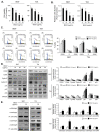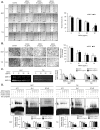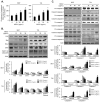A Novel Cyclic Pentadepsipeptide, N-Methylsansalvamide, Suppresses Angiogenic Responses and Exhibits Antitumor Efficacy against Bladder Cancer
- PMID: 33430488
- PMCID: PMC7827157
- DOI: 10.3390/cancers13020191
A Novel Cyclic Pentadepsipeptide, N-Methylsansalvamide, Suppresses Angiogenic Responses and Exhibits Antitumor Efficacy against Bladder Cancer
Abstract
Here, we explored the anti-tumor efficacy of a cyclic pentadepsipeptide, N-methylsansalvamide (MSSV), in bladder cancer. MSSV inhibited the proliferation of both bladder cancer 5637 and T24 cells, which was attributed to the G1-phase cell cycle arrest, apoptosis induction, and alteration of mitogen-activated protein kinases (MAPKs) and protein kinase b (AKT) signaling pathways. Additionally, the treatment of bladder cancer cells with MSSV suppressed migratory and invasive potential via the transcription factor-mediated expression of matrix metalloproteinase 9 (MMP-9). MSSV abrogated vascular endothelial growth factor (VEGF)-induced angiogenic responses in vitro and in vivo. Furthermore, our result showed the potent anti-tumor efficacy of MSSV in a xenograft mouse model implanted with bladder cancer 5637 cells. Finally, acute toxicity test data obtained from blood biochemical test and liver staining indicated that the oral administration of MSSV at 2000 mg/kg caused no adverse cytotoxic effects. Our preclinical data described the potent anti-angiogenic and anti-tumor efficacy of MSSV and showed no signs of acute toxicity, thereby suggesting the putative potential of oral MSSV as a novel anti-tumor agent in bladder cancer treatment.
Keywords: MSSV; anti-angiogenesis; anti-tumor efficacy; bladder cancer; single oral dose of acute toxicity.
Conflict of interest statement
The authors declare no conflict of interest.
Figures







Similar articles
-
N-methylsansalvamide elicits antitumor effects in colon cancer cells in vitro and in vivo by regulating proliferation, apoptosis, and metastatic capacity.Front Pharmacol. 2023 Mar 16;14:1146966. doi: 10.3389/fphar.2023.1146966. eCollection 2023. Front Pharmacol. 2023. PMID: 37007044 Free PMC article.
-
Triacanthine exerts antitumor effects on bladder cancer in vitro and in vivo.Phytomedicine. 2019 Nov;64:153069. doi: 10.1016/j.phymed.2019.153069. Epub 2019 Aug 9. Phytomedicine. 2019. PMID: 31421400
-
CEP-7055: a novel, orally active pan inhibitor of vascular endothelial growth factor receptor tyrosine kinases with potent antiangiogenic activity and antitumor efficacy in preclinical models.Cancer Res. 2003 Sep 15;63(18):5978-91. Cancer Res. 2003. PMID: 14522925
-
Magnolol suppresses hypoxia-induced angiogenesis via inhibition of HIF-1α/VEGF signaling pathway in human bladder cancer cells.Biochem Pharmacol. 2013 May 1;85(9):1278-87. doi: 10.1016/j.bcp.2013.02.009. Epub 2013 Feb 14. Biochem Pharmacol. 2013. PMID: 23416116
-
Adenoviral mediated interferon-alpha 2b gene therapy suppresses the pro-angiogenic effect of vascular endothelial growth factor in superficial bladder cancer.J Urol. 2007 May;177(5):1900-6. doi: 10.1016/j.juro.2007.01.003. J Urol. 2007. PMID: 17437845
Cited by
-
A novel tubulin inhibitor, 6h, suppresses tumor-associated angiogenesis and shows potent antitumor activity against non-small cell lung cancers.J Biol Chem. 2022 Jul;298(7):102063. doi: 10.1016/j.jbc.2022.102063. Epub 2022 May 23. J Biol Chem. 2022. PMID: 35618020 Free PMC article.
-
N-methylsansalvamide elicits antitumor effects in colon cancer cells in vitro and in vivo by regulating proliferation, apoptosis, and metastatic capacity.Front Pharmacol. 2023 Mar 16;14:1146966. doi: 10.3389/fphar.2023.1146966. eCollection 2023. Front Pharmacol. 2023. PMID: 37007044 Free PMC article.
-
Rosa hybrida Petal Extract Exhibits Antitumor Effects by Abrogating Tumor Progression and Angiogenesis in Bladder Cancer Both In Vivo and In Vitro.Integr Cancer Ther. 2022 Jan-Dec;21:15347354221114337. doi: 10.1177/15347354221114337. Integr Cancer Ther. 2022. PMID: 35912937 Free PMC article.
-
Anti-cancer properties of Sansalvamide A, its derivatives, and analogs: an updated review.Naunyn Schmiedebergs Arch Pharmacol. 2024 Oct;397(10):7337-7351. doi: 10.1007/s00210-024-03129-0. Epub 2024 May 13. Naunyn Schmiedebergs Arch Pharmacol. 2024. PMID: 38739152 Review.
References
-
- Zachos I., Konstantinopoulos P.A., Tzortzis V., Gravas S., Karatzas A., Karamouzis M.V., Melekos M., Papavassiliou A.G. Systemic Therapy of Metastatic Bladder Cancer in the Molecular Era: Current Status and Future Promise. Expert Opin. Investig. Drugs. 2010;19:875–887. doi: 10.1517/13543784.2010.496450. - DOI - PubMed
Grants and funding
LinkOut - more resources
Full Text Sources
Other Literature Sources
Miscellaneous

